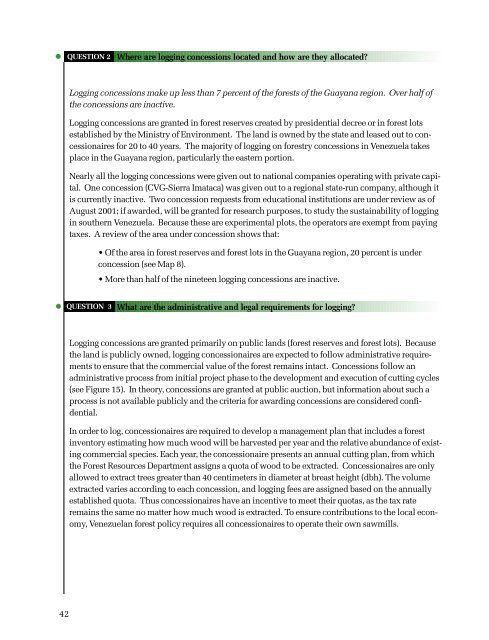Usar pâgs xvii-134 - ResearchGate
Usar pâgs xvii-134 - ResearchGate
Usar pâgs xvii-134 - ResearchGate
You also want an ePaper? Increase the reach of your titles
YUMPU automatically turns print PDFs into web optimized ePapers that Google loves.
• QUESTION 2 Where are logging concessions located and how are they allocated?Logging concessions make up less than 7 percent of the forests of the Guayana region. Over half ofthe concessions are inactive.Logging concessions are granted in forest reserves created by presidential decree or in forest lotsestablished by the Ministry of Environment. The land is owned by the state and leased out to concessionairesfor 20 to 40 years. The majority of logging on forestry concessions in Venezuela takesplace in the Guayana region, particularly the eastern portion.Nearly all the logging concessions were given out to national companies operating with private capital.One concession (CVG-Sierra Imataca) was given out to a regional state-run company, although itis currently inactive. Two concession requests from educational institutions are under review as ofAugust 2001; if awarded, will be granted for research purposes, to study the sustainability of loggingin southern Venezuela. Because these are experimental plots, the operators are exempt from payingtaxes. A review of the area under concession shows that:• Of the area in forest reserves and forest lots in the Guayana region, 20 percent is underconcession (see Map 8).• More than half of the nineteen logging concessions are inactive.• QUESTION 3 What are the administrative and legal requirements for logging?Logging concessions are granted primarily on public lands (forest reserves and forest lots). Becausethe land is publicly owned, logging concessionaires are expected to follow administrative requirementsto ensure that the commercial value of the forest remains intact. Concessions follow anadministrative process from initial project phase to the development and execution of cutting cycles(see Figure 15). In theory, concessions are granted at public auction, but information about such aprocess is not available publicly and the criteria for awarding concessions are considered confidential.In order to log, concessionaires are required to develop a management plan that includes a forestinventory estimating how much wood will be harvested per year and the relative abundance of existingcommercial species. Each year, the concessionaire presents an annual cutting plan, from whichthe Forest Resources Department assigns a quota of wood to be extracted. Concessionaires are onlyallowed to extract trees greater than 40 centimeters in diameter at breast height (dbh). The volumeextracted varies according to each concession, and logging fees are assigned based on the annuallyestablished quota. Thus concessionaires have an incentive to meet their quotas, as the tax rateremains the same no matter how much wood is extracted. To ensure contributions to the local economy,Venezuelan forest policy requires all concessionaires to operate their own sawmills.42
















